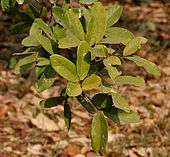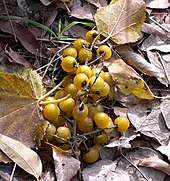Sapindus
Sapindus is a genus of about five to twelve species of shrubs and small trees in the Lychee family, Sapindaceae, native to warm temperate to tropical regions of the world. The genus includes both deciduous and evergreen species. Members of the genus are commonly known as soapberries[3] or soapnuts because the fruit pulp is used to make soap. The generic name is derived from the Latin words sapo, meaning "soap", and indicus, meaning "of India".[4]
| Sapindus | |
|---|---|
 | |
| Sapindus marginatus shrubs | |
| Scientific classification | |
| Kingdom: | Plantae |
| Clade: | Tracheophytes |
| Clade: | Angiosperms |
| Clade: | Eudicots |
| Clade: | Rosids |
| Order: | Sapindales |
| Family: | Sapindaceae |
| Subfamily: | Sapindoideae |
| Genus: | Sapindus L. |
| Type species | |
| Sapindus saponaria L.[1] | |
| Species | |
|
See text | |
| Synonyms | |
|
Dittelasma Hook.f.[2] | |
The leaves are alternate, 15–40 cm (5.9–15.7 in) long, pinnate (except in S. oahuensis, which has simple leaves), with 14-30 leaflets, the terminal leaflet often absent. The flowers form in large panicles, each flower small, creamy white. The fruit is a small leathery-skinned drupe 1–2 cm (0.39–0.79 in) in diameter, yellow ripening blackish, containing one to three seeds.
Uses


The drupes (soapnuts) contain saponins, which have surfactant properties, having been used for washing by ancient Asian people and Native Americans.[5]
Folk medicine
Soapnuts have historically been used in folk remedies,[6] but, as the effectiveness of such treatments has not been subjected to scientific scrutiny, there are no confirmed health benefits of using soapnuts to treat any human disease. The soapnut contains saponins, which are under laboratory research for their potential antimicrobial properties.[6]
Insecticide
Sapindus species are used as food plants by the larvae of some Lepidoptera (moths and butterflies) species including Endoclita malabaricus. Kernel extracts of soapnut disrupt the activity of enzymes of larvae and pupae and inhibits the growth of the mosquito Aedes aegypti, an important vector of viral diseases.[7]
Dyeing agent
Soapnut is used as a dyeing agent for coloring the yarn of Tussar silk and cotton.[8]
Species


The number of species is disputed between different authors, particularly in North America where between one and three species are accepted.
- Sapindus delavayi (China, India)
- Sapindus detergens (syn. var. Soapnut, Ritha)
- Sapindus emarginatus Vahl (Southern Asia)
- Sapindus laurifolius Vahl – Ritha (India)
- Sapindus marginatus Willd. – Florida Soapberry (Florida to South Carolina); included in S. saponaria by some authors.
- Sapindus mukorossi Gaertn. – Indian Soapberry (Northern India east to the Himalayas)
- Sapindus oahuensis Hillebr. ex Radlk. – Lonomea (Kauaʻi and Oʻahu, Hawaii)
- Sapindus rarak DC. (Southeast Asia)
- Sapindus saponaria L.
- S. s. var. drummondii (Hook. & Arn.) L.D.Benson – Western Soapberry (southwestern United States, Mexico)
- S. s. var. saponaria – Wingleaf Soapberry (southeastern United States, Caribbean, island of Hawaiʻi, Central and South America)
- Sapindus tomentosus (China)
- Sapindus trifoliatus L. – South India Soapnut or Three-leaf Soapberry (Southern India, Pakistan)
- Sapindus vitiensis A.Gray (American Samoa, Samoa, Fiji)[3][9][10]
Formerly placed here
- Lepisanthes fruticosa (Roxb.) Leenh. (as S. fruticosus Roxb.)
- Lepisanthes senegalensis (Juss. ex Poir.) Leenh. (as S. senegalensis Juss. ex Poir.)
- Lepisanthes tetraphylla (Vahl) Radlk. (as S. tetraphylla Vahl)
- Talisia cerasina (Benth.) Radlk. (as S. cerasinus Benth.)
- Talisia esculenta (A.St.-Hil.) Radlk. (as S. esculenta A.St.-Hil.)[10]
References
- "Sapindus L." TROPICOS. Missouri Botanical Garden. Retrieved 2010-01-13.
- "Genus: Sapindus L." Germplasm Resources Information Network. United States Department of Agriculture. 2007-10-05. Retrieved 2010-01-13.
- "Sapindus". Integrated Taxonomic Information System. Retrieved 2010-11-01.
- Quattrocchi, Umberto (2000). CRC World Dictionary of Plant Names: Common Names, Scientific Names, Eponyms, Synonyms, and Etymology. IV R-Z. Taylor & Francis US. p. 2381. ISBN 978-0-8493-2678-3.
- Austin, Daniel F. (2004). Florida Ethnobotany. CRC Press. pp. 601–603. ISBN 978-0-8493-2332-4.
- Upadhyay A, Singh DK (2012). "Pharmacological effects of Sapindus mukorossi". Revista do Instituto de Medicina Tropical de São Paulo. 54 (5): 273–280. doi:10.1590/s0036-46652012000500007. PMID 22983291.
- "Soapnut, a mosquito repellent". Down To Earth.
- Deshmukh A, Bansal L (2014). "Sapindus emarginatus Vahl as a natural scouring agent in dyeing of cotton with Carissa carandas leaf extract" (PDF). BioLife. 2 (2): 599–604.
- "Sapindus vitiensis". Germplasm Resources Information Network (GRIN). Agricultural Research Service (ARS), United States Department of Agriculture (USDA). Retrieved 2009-03-23.
- "GRIN Species Records of Sapindus". Germplasm Resources Information Network. United States Department of Agriculture. 2007-04-30. Retrieved 2010-11-01.
External links
| Wikimedia Commons has media related to Sapindus. |
| Wikispecies has information related to Sapindus |